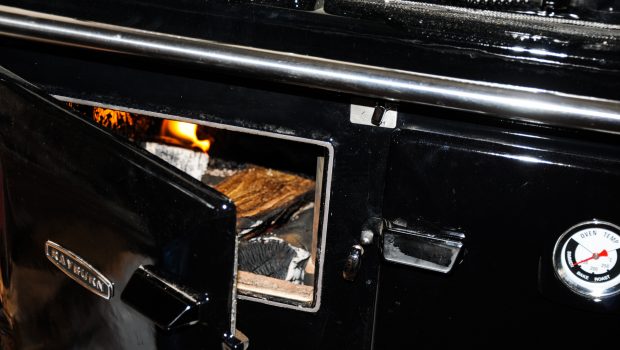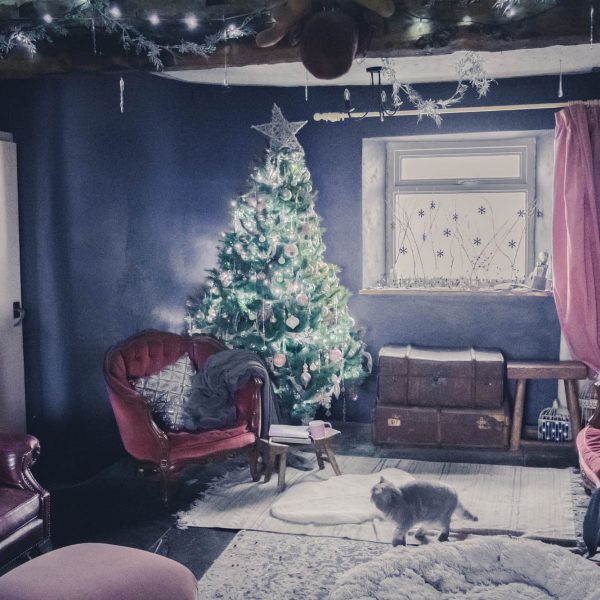My posts about the Rayburn 345W are still some of my most popular as there is so little information about them. Now we’ve had ours for four years, I thought I’d put together a list of practicalities that should be considered if you’re thinking about heating your house with wood….
(I’ll refer to the Rayburn as that is what I have, but this applies to any wood-fired boiler type heating system.)
1. Is there someone at home all day? You bank down the fire box overnight, but it won’t bank down from 9-5 as well if you’re out at work. Even if you’re up early and get it roaring into life for a couple of hours before leaving the house, you may be able to get it bank down for the day, but tar deposits will soon build up in your chimney and cause problems. Also, I’d be surprised if your house would ever feel properly warm.
2. What sort of flooring do you have in your kitchen? It needs to be hardwearing enough to withstand a wheel-barrow loaded with logs going across it and ideally heat-proof as hot ash pans, partly burned logs and hot pokers will invariably end up on your floor. Whatever it is, give it a good layer of padding – perhaps an old thick carpet – when the oven is delivered – the weight of it being brought in will crack your tiles.
3. How much space do you have? We have about a 1m square log basket next to the oven. This can take 2 wheel-barrow loads of logs piled high, which lasts a day and night in really cold weather. (Most of the time 1 heaped wheel-barrow plus an armful is enough.)
Also, you will need space for a back-up cooker for when the fire won’t get going when you want it to, and for the summer as it is unlikely you’ll have it lit then. We have a counter-top halogen oven which does us fine most of the time, and a baby-Belling under the sink for cakes as the halogen oven is useless for cakes; and when I’m feeding more than the usual family. And a microwave.
4. Do you have a strong back? Mine gets stronger throughout the winter! However, bending over to collect the logs into the barrow, and then bending over again to get them from the barrow to the basket can be quite tough on the old back. My thighs also get stronger in winter from squatting and strange lunging positions I do to avoid back-ache.
5. Do you have a big/shabby driveway? We inherited from the previous owners a rough, patched up driveway with a concrete/rubbly surface. Not pretty, and therefore not a problem when the truck reverses along it and dumps a tonne and a half of logs onto it. Will you have somewhere else to park your car?
6.Where will you store your logs? The first year I immediately spent a day wheeling several barrow-loads of logs to the shed and stacked them neatly and tidily against the wall in rows. By the end of the second year we were chucking over a ground-sheet where they were unloaded. Last year though, in the torrential storms the country suffered from, water seeped through the groundsheet and the gales through it off several times despite many rocks holding it down. It rained constantly for weeks, which made it impossible to move them to the shed anyway. This year I have three layers of groundsheet and a system that whenever I bring one load into the kitchen, I take two to the shed so after a few days it’s all done. Ideally wherever you keep them won’t be too far from the kitchen! If you haven’t got a shed or secure log shelter think about how you’ll keep them safe – if they’re left on your front drive you could end up heating the neighbouring houses as well as your own!
7. How much time do you have? In one go it takes me about four hours to shift a tonne and half of logs to the shed. Of course, this depends on the distance from the dumped logs to your shelter. I treat it like a good free workout – lots of squatting and twisting and I usually lose a pound or two that day! Also, we’ve recently started to let the Rayburn go out on a fortnightly basis to completely sweep the chimney. Once a month we give the whole thing a thorough clean, which takes about forty-five minutes. In really cold January weather, the Rayburn needs checking on and another couple of logs added on an hourly basis.
8. How strong are you? In order to give the Rayburn a thorough clean, you have to lift the iron plate off the top so you can sweep through the soot. This is extremely heavy. I recommend going to a show-room and checking you can lift this off, (the whole thing – not just the small round bit) place it on the floor and lift it on again.
9. How pernickety are you about dirt and dust? If you love cleaning or are one of these strange people who find it therapeutic, then great – you’ll love it because you’ll need to clean your kitchen three times more often than you used to. If you like a spotless kitchen, but hate cleaning, then a wood-fired oven is not for you. We don’t eat off our kitchen floor, so I don’t worry too much about it. I wipe off an inch of dust when my parents are due to visit.
10. Do you get your fingernails done? If so, save your money when you’ve got the Rayburn lit – it isn’t worth trying to keep them nice! My nails are frankly embarrassing in winter – thank god for gloves! After cleaning tar from the flue chamber, they are black for a week no matter how long you soak them. They will also break and chip below the base of the nails regularly just from picking up the logs slightly wrong.
11. Do you have patience? I read a message board somewhere with someone complaining about the lack of instructions and lack of help from Rayburn customer services. This is true – from the sounds of it, no-one at customer services actually owns a wood-fired Rayburn themselves. You are given basic instructions when you buy one – how to bank it down; and that’s pretty much it. You are really left to figure it out for yourselves. The knack of how to control it is definitely only learned by experience. Please type in ‘Rayburn’ in the search bar on my page for other pieces of advice. I’ll be writing more about this over the winter season, so please come back to have a look.
I’m sure there are more things to add – I’ll edit this post as and when I think of them. Please leave a comment if you’re a wood-fired oven owner and can think of something I’ve forgotten and together we can save the world from unprepared Rayburn owners!





Ken Grayling
February 8, 2022We’ve had ours for 14 years and have finally taken the plunge and gotten an air-source heat pump installed. We always had a leccy cooker for summer. Logs were about £50 a week and I defy anyone to give a weight for the delivery – just a ‘load’!
The other issue now is how to get rid of the thing – a quick look on eBay will disabuse you of any notion of recouping the ‘investment.
On the upside, a glowing Rayburn is very comforting – we’re getting a wood burner installed in the living room for extra cheer and resilience during power cuts. A Rayburn ‘on song’ can cook in a trice, even soufles. But, as my then early-teen grandson said, why no glass window so you can see if the thing is lit or needs refuelling without sending a gout of smoke into the room.
The boiler side ran seven rads, once it had built up heat (midday), so the immersion heater was always on….
As for the installation, I could write a book. We had to use a Rayburn-accredited engineer, but when they were told about his many cock-ups, they said ‘your contract is with the installer’s…
Anyway, thanks for an interesting read.